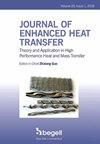多孔镍微结构表面的池沸腾传热特性
IF 1.5
4区 工程技术
Q3 ENGINEERING, MECHANICAL
引用次数: 0
摘要
电池热管理系统中的池沸腾作为一种有效的散热机制,可以大大降低这种风险。在这项研究中,我们电化学沉积了一个光滑的镍试样和三个具有多孔镍堆积结构的试样。通过扫描电子显微镜对这四种试样进行了微结构表征。通过目视实验,我们评估了它们的润湿性;通过池沸实验,我们测试了它们的沸腾传热性能。我们的研究结果表明,含有多孔镍结构的样品在传热效率方面始终优于未经改性的样品。与光滑的镍样品相比,电流密度为 0.5 A-cm-2 的样品表现出最佳的沸腾传热性能,沸腾开始时的温度降低了 65.6%,临界热通量密度提高了 16.1%,最大传热系数提高了 160.7%。多孔镍结构样品的优异性能可归因于有更多的成核点。此外,电流密度为 0.5 A-cm-2 的样品显示出较小的微晶树枝状结构,这一特性进一步影响了其沸腾传热性能。本文章由计算机程序翻译,如有差异,请以英文原文为准。
Pool boiling heat transfer characteristics of porous nickel microstructure surfaces
Pool boiling as a mechanism for effective heat dissipation in battery thermal management systems can considerably mitigate this risk. In this study, we electrochemically deposited one smooth nickel specimen and three specimens with a porous nickel-stacked structure. The four samples underwent microstructural characterization via scanning electron microscopy. Through visual experiments, we evaluated their wettability, and through pool boiling experiments, we tested their boiling heat transfer properties. Our findings suggest that samples incorporating a porous nickel structure consistently outperform unmodified samples regarding heat transfer efficiency. Specifically, samples with a current density of 0.5 A·cm-2 demonstrated the most optimal boiling heat transfer performance, evidenced by a 65.6% reduction in temperature at the onset of boiling, a 16.1% increase in critical heat flux density, and a 160.7% larger maximum heat transfer coefficient compared to the smooth nickel sample. The superior performance of samples with porous nickel structures can be attributed to the availability of a more significant number of nucleation sites. Additionally, specimens with a current density of 0.5 A·cm-2 displayed smaller micro-crystalline dendritic structures, an attribute that further favorably influenced their boiling heat transfer performance.
求助全文
通过发布文献求助,成功后即可免费获取论文全文。
去求助
来源期刊

Journal of Enhanced Heat Transfer
工程技术-工程:机械
CiteScore
3.60
自引率
8.70%
发文量
51
审稿时长
12 months
期刊介绍:
The Journal of Enhanced Heat Transfer will consider a wide range of scholarly papers related to the subject of "enhanced heat and mass transfer" in natural and forced convection of liquids and gases, boiling, condensation, radiative heat transfer.
Areas of interest include:
■Specially configured surface geometries, electric or magnetic fields, and fluid additives - all aimed at enhancing heat transfer rates. Papers may include theoretical modeling, experimental techniques, experimental data, and/or application of enhanced heat transfer technology.
■The general topic of "high performance" heat transfer concepts or systems is also encouraged.
 求助内容:
求助内容: 应助结果提醒方式:
应助结果提醒方式:


